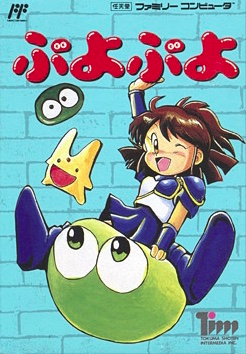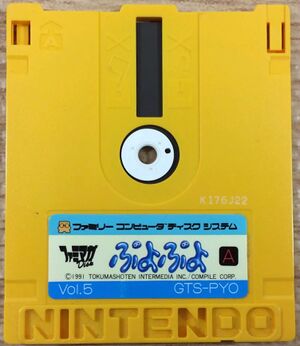Puyo Puyo: Difference between revisions
PanchamBro (talk | contribs) m (added Category:Famicom Disk System games using HotCat) |
mNo edit summary |
||
| (17 intermediate revisions by 4 users not shown) | |||
| Line 1: | Line 1: | ||
{{Infobox-game | |||
| game = Puyo Puyo | |||
| displaytitle = ''Puyo Puyo'' | |||
| image = | |||
<tabs> | |||
<tab name="Famicom box art"> | |||
[[File:Puyo Puyo FC Box Art.jpg|300px]] | |||
</tab> | |||
<tab name="Famicom cartridge"> | |||
[[File:Puyo Puyo FC Cartridge.jpg|300px]] | |||
</tab> | |||
<tab name="Disk System disk (Side A)"> | |||
[[File:Puyo Puyo FDS Disk Side A.jpg|300px]] | |||
</tab> | |||
<tab name="Disk System disk (Side B)"> | |||
[[File:Puyo Puyo FDS Disk Side B.jpg|300px]] | |||
</tab> | |||
</tabs> | |||
| japanese-name = ぷよぷよ | |||
| developer = [[Compile]] | |||
| publisher = [[Tokuma Shoten]] | |||
| yen = 5900 | |||
| cartridge-code = GTS-PYO (Famicom Disk System), TIM-PY (Famicom) | |||
| fds-date = October 25, 1991 | |||
| famicom-date = July 23, 1993 | |||
| wikipedia = Puyo Puyo (video game) | |||
| jpwikipedia = ぷよぷよ | |||
| puyonexus = Puyo Puyo (1991) | |||
}} | |||
'''''Puyo Puyo''''' (ぷよぷよ) is a tile-matching game developed by [[Compile]] and published by [[Tokuma Shoten]]. It released on October 25, 1991 for the [[Family Computer Disk System]] and on July 23, 1993 for the [[Family Computer]]. The Disk System version was originally released as '''''Famimaga Disk Vol. 5: Puyo Puyo''''' (ファミマガディスク Vol.5 ぷよぷよ) as a pack-in for Tokuma Shoten's Famimaga magazine. | '''''Puyo Puyo''''' (ぷよぷよ) is a tile-matching game developed by [[Compile]] and published by [[Tokuma Shoten]]. It released on October 25, 1991 for the [[Family Computer Disk System]] and on July 23, 1993 for the [[Family Computer]]. The Disk System version was originally released as '''''Famimaga Disk Vol. 5: Puyo Puyo''''' (ファミマガディスク Vol.5 ぷよぷよ) as a pack-in for Tokuma Shoten's Famimaga magazine. | ||
[[Category: | ===Gameplay=== | ||
[[Category: | ''Puyo Puyo'' has two modes: Endless and Mission. Players control various coloured slimes, or Puyo, as they fall from the top of a grid. The Puyo fall in groups of two, and in up to six different colours. The Puyo can be rotated and moved horizontally. When four or more Puyo connect adjacently, they disappear and grant points. In Endless Mode, players play until the third of six columns fills to the top. In Mission Mode, the same controls apply, but with certain goals given in the bottom right that the player must complete to move onto the next level. Goals include such things as matching six Puyo at the same time, clearing all of the same colour, or creating a long enough chain of successively matching Puyo. | ||
[[Category:1991 software]] | |||
[[Category:1993 software]] | |||
[[Category:No Japanese Required]] | |||
Revision as of 21:44, 17 January 2024
ぷよぷよ
Puyo Puyo (ぷよぷよ) is a tile-matching game developed by Compile and published by Tokuma Shoten. It released on October 25, 1991 for the Family Computer Disk System and on July 23, 1993 for the Family Computer. The Disk System version was originally released as Famimaga Disk Vol. 5: Puyo Puyo (ファミマガディスク Vol.5 ぷよぷよ) as a pack-in for Tokuma Shoten's Famimaga magazine.
Gameplay
Puyo Puyo has two modes: Endless and Mission. Players control various coloured slimes, or Puyo, as they fall from the top of a grid. The Puyo fall in groups of two, and in up to six different colours. The Puyo can be rotated and moved horizontally. When four or more Puyo connect adjacently, they disappear and grant points. In Endless Mode, players play until the third of six columns fills to the top. In Mission Mode, the same controls apply, but with certain goals given in the bottom right that the player must complete to move onto the next level. Goals include such things as matching six Puyo at the same time, clearing all of the same colour, or creating a long enough chain of successively matching Puyo.



